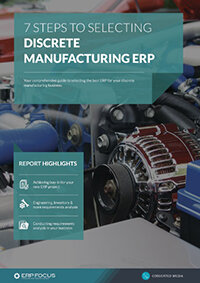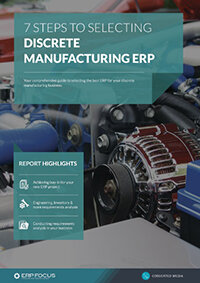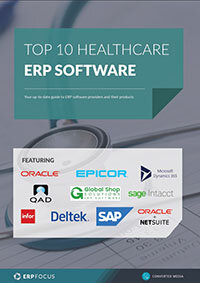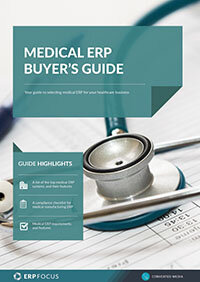Five features to look for in a medical manufacturing ERP
While ‘typical’ ERP systems primarily orient themselves to matters of soft/hard resource management, when one is considering a manufacturing platform in the medical segment, additional policy, or ‘business rule’ elements apply. This is largely due to stringent quality and processing regulations at Federal and State levels.
Consequently, rather than looking at ERP from a general feature/function perspective, I will offer a policy-based approach to the medical segment itself.
Most medical ERP suites provide for general feature sets that support compliance and quality as core operating characteristics. These elements define inter-system communication, while at the same time, applying various functional rules during direct/in-direct collaboration between work-centers.
Guide: seven steps to selecting manufacturing ERP
However, med-tech is quite dense at a policy level, and is typically more rigid than most other ERP platforms. For example, let’s look at five featured elements associated with integrated policies:
1. ISO compliance
ISO 13485 - This operating standard directly applies to the ERP-based manufacture of medical devices. The standard defines “…an International Organization for Standardization (ISO) doctrine, initially released in 1996. The protocol establishes requirements for comprehensive quality management systems in the design and manufacture of medical devices. The standard supersedes earlier less stringent documents including; EN 46001, EN 46002, and previously ISO 13485 and ISO 13488.”
This standards framework is typically integrated and applied within all comprehensive med-tech ERP platforms, and specifically applies to function sets associated with risk mitigation, and enhanced compliance.
2. Quality management
ISO 9001 - In concert with ISO 13485, ISO 9001 also applies, and in particular associates itself with to non-domestic med-tech manufacturing systems. In this case the standard defines “…a family of quality management standards, designed to help organizations ensure that they meet customer quality requirements, while also ensuring that statutory and regulatory requirements associated with a medically relevant product or service.”
Again, this standard is typically applied with all comprehensive med-tech ERP platforms, but more specifically; overall process quality, and asset tracking.
3. Compliance to Code of Federal Regulations (CFR) Title 21
Because med-tech processes call for end-to-end quality assurance throughout the manufacturing chain, regulations associated with how electronic records are managed and stored. In this case, CFR Title 21 applies directly to low-level compliance within most comprehensive med-tech systems. The regulatory frames establishes “…regulations (and) criteria, under which agencies consider electronic records, electronic signatures, and handwritten signatures executed to electronic records to be trustworthy, reliable, and generally equivalent to paper records and handwritten signatures executed on paper.”
This regulatory constraint applies directly to ERP operations associated with the production of Class 1, 2, and 3 medical devices. In this case, particular business values are integrated throughout all med-tech ERP processes.
4. Electronic document control
Electronic signature/document control CFR Title 21, Part 11 – This supporting section relates to electronic document control, and typical of med-tech ERP business rules. To wit; “This part applies to records in electronic form that are created, modified, maintained, archived, retrieved, or transmitted, under any records requirements set forth in agency regulations. This part also applies to electronic records submitted to the agency under requirements of the Federal Food, Drug, and Cosmetic Act and the Public Health Service Act, even if such records are not specifically identified in agency regulations. However, this part does not apply to paper records that are, or have been, transmitted by electronic means.”
This particular policy constraint applies to both ERP-based asset-track processes, in addition to ensuring that proper security and ‘chains of evidence’ are applied through the manufacturing continuum.
5. Comprehensive Corrective Action/Preventive Action (CA/PA)
While CA/PA elements are not necessarily oriented to domestic and/or international standards per se; under FDA CFR 21, Section 800 specific CA/PA processes apply as compliance sets. Consequently most comprehensive ERP med-tech systems apply CA/PA when developing internal processes including:
- Process Design/Re-design.
- Product Design/Re-design.
- Training and/or enhancement/modification of training programs.
- Improved validation of maintenance schedules.
- Improved material handling or storage processes.
These five focus points are just the top of the iceberg when it comes to compliance and quality assurance related to med-tech ERP platforms. Nevertheless, they do offer some guidance that should get you thinking in the right direction.
Free white paper

7 steps to selecting discrete manufacturing ERP
17 pages of ERP selection advice and industry requirements analysis

Featured white papers
Related articles
-

How to use ERP project management tools to improve efficiency
Advice on using your ERP project management tools to their full potential
-

CMMC Compliance: What Aerospace and Defense Manufacturers Need to Know
Key insights on CMMC compliance, deadlines, and securing DoD contracts with CMMC 2.0 certificatio...
-

ERP vs. HRMS: which should manage your payroll?
Compare the advantages and disadvantages of using HRMS or ERP to manage your payroll




